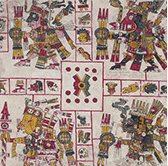Publishing
HISTORICAL NOTES
The editorial work of the Vatican Library has its roots in the very origins of printing. Even before a printing press was created for the exclusive use of the Holy See, Bishop Giovanni Andrea Bussi (1417-1475), a member of the circle of Nicholas V and the predecessor of Platina in the office of Librarian of the Vatican Library (1471-1475), realized the potential of the invention of printing. Indeed, as early as 1468 (even before his appointment to the Library), he began to produce editiones principes of many Latin works for the printing press of Conrad Sweynheym and Arnold Pannartz, the pioneers from Mainz who introduced the art of printing into Italy, first at Subiaco and then in Rome.
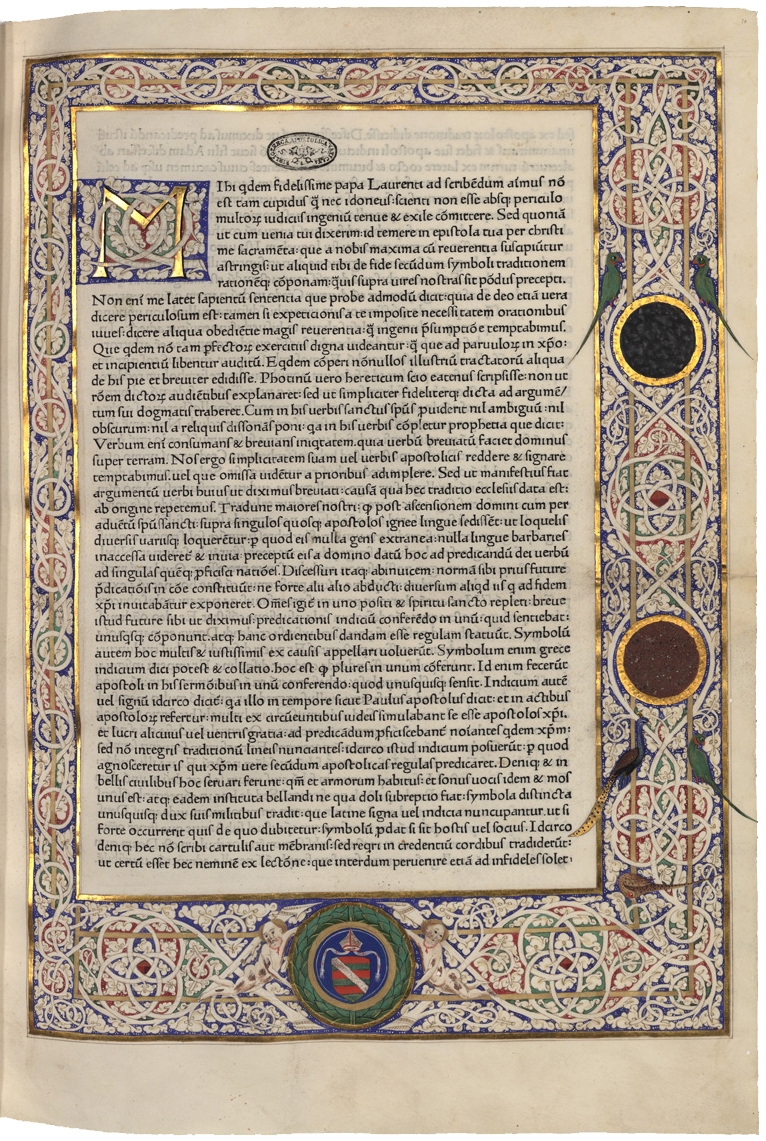
editio princeps printed in Rome by Sweynheym and
Pannartz, December 13, 1468, edited by G. A. Bussi,
whose episcopal coat of arms appears at the
bottom of the page
Bussi´s printing activities were continued in the work of the first Cardinal Librarian, Marcello Cervini (1550-1555) - he was later to become Pope, for less than a month, with the name of Marcellus II - who not only directed his attention to the choice of texts for publication, but also to typeface improvement, extending also to non-Latin alphabets. For this purpose, he received the counsel of Paolo Manuzio, and employed various independent printers, including such major names in the history of Italian publishing as Blado, Giunti and Priscianese. Thanks to Cervini´s involvement and, later, to the express wish of Pius IV (1559-1565), a print shop was opened in Rome which began operations in December 1561, under the supervision of the four Cardinals "deputati sopra la stampa", employing printers such as Paolo Manuzio and Antonio Blado. At the end of 1563, it became the property of the municipality or "people" of Rome; it ceased operations sometime after 1570.
A pontifical printing press, with technical and scientific staff in the direct service of the Holy See, having as its main purpose the publication and dissemination of knowledge of the manuscripts kept there, was established under Sixtus V (1585-1590) with the bull Eam semper ex omnibus (April 27, 1587). A little later, the bull Immensa aeterni Dei (January 22, 1588) established a Congregation of Cardinals pro Typographia Vaticana, with the mandate of ensuring that the publications (including editions in the vernacular as well as in Latin, Greek and Oriental languages, in the original alphabets, relating mainly to the Holy Scriptures, the Church Fathers, collections of Papal Bulls, and other ecclesiastical works in defense of the faith) complied with the requirements of the Council of Trent. 1590 saw the first official edition of the Vulgata, the so-called "Sistine Bible", which was replaced in 1592 by the "Clementine Bible." In the same year, Domenico Basa was appointed to lead the press, with the title Praefectus officinae impressoriae. In 1593, Clement VIII (1592-1605) modified the Library´s management and staff by establishing the role of ´correttori´. Their task was closely linked to the new institution and instrumental in the establishment of a concrete publishing program.
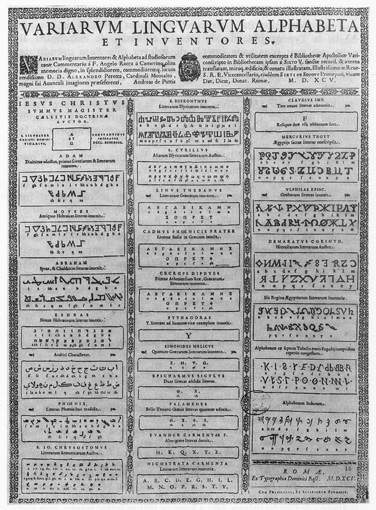
with the characters used by the Vatican Press
directed by Domenico Basa
During the seventeenth century, the Press associated with the Library ceased to exist, having been suppressed by a chirograph of Paul V (1605-1621), dated September 30, 1609. However, the Library maintained a constant relationship with the Stamperia Camerale, which had incorporated the older Press, according to the wishes of the same Pope. Clement XI (1700-1721), during the first year of his pontificate, received from the first custos of the Library, Lorenzo Alessandro Zaccagni, a memorial and a detailed plan to reopen the Press next to the Library; but the effective reopening was not to occur until the time of Leo XII (1823-1829).
Nonetheless, in the eighteenth century the Library continued to be a repository of valuable typographic material, possessing fonts and plates, creating new fonts and preparing many publications pertaining to its own manuscript collections. Under the guidance of Cardinal Domenico Passionei, the Library developed a real editorial policy, assigning to the various officers of the Library works to continue or to be undertaken. 1756 saw the beginnings of a general description of the Library's manuscripts, with the catalog of the manuscripts in oriental languages edited by Giuseppe Simonio and Stefano Evodia Assemani and published by Angelo Rotili, printer and maker of fine oriental fonts, in the Palazzo Massimo alle Colonne; it was to include six volumes, but was interrupted after the third; a further planned extension, including the manuscripts in Greek, Latin and other languages, in 20 volumes, was never realized at all.
It was Leo XII who restored life to the Vatican Printing Press, in 1825, giving it the most modern equipment of the time, including new fonts and presses purchased in England. Angelo Mai, Primus Custos of the Library (1819-1833) and later Cardinal Librarian (1853-1854), the «scopritor famoso» («famous discoverer»), as the poet Giacomo Leopardi called him, gave special impetus to the publication of texts drawn from the Library's manuscripts, both sacred and secular; the first and most famous was that of Cicero's hitherto unpublished De re publica, whose editio princeps appeared in 1822 at the printing press of Francesco Bourliè, using
a majestic new font which Mai had had made. Mai was also the originator of the idea of a facsimile edition of the Codex B (Vat. gr. 1209), one of the oldest and most illustrious witnesses of the Bible, an idea which came to fruition only later, between 1868 and 1881 (from the press of the Propaganda Fide), and again in 1889-1890 (from the Vatican Library), 1904-1907 (from the Milanese publisher Hoepli) and 1999 (from the Italian Istituto Poligrafico e Zecca dello Stato).
A historic milestone is marked by Leo XIII (1878-1903), who opened the Library to a wider readership, one consequence of which was the renewed vigour which was applied to the preparation of printed catalogs of manuscripts and and to editorial work. In the second year of his pontificate, he appointed the "Commission for the Publication of the Catalogues of the Vatican Library", presided over by Cardinal Librarian Jean-Baptiste Pitra and active from 1880 to 1897. In these and in subsequent years several catalogs were published in the series Bibliothecae Apostolicae Vaticanae Codices manuscripti recensiti, many of which concern the manuscripts of the Vaticani shelf-mark series, while others concerned such collections as the Palatini, Reginensi, Urbinati, Capponiani, Ottoboniani, Chigiani, Ferrajoli, and Barberiniani. A certain degree of diversity persists in the guiding principles of the catalogs published prior to the prefecture of Fr Franz Ehrle(1895-1914), who established more precise and constant criteria for analytical description of the manuscripts: these rules, published as Leges quas curatores bibliothecae Vaticanae in codicibus latinis o graecis recensendis sibi constituerunt in an appendix to the Preface of the catalogue of the Codices Vaticani Latini, 1-678, edited by M.Vattasso and P. Franchi de' Cavalieri in 1902, and of the catalog of Codices Urbinates Latini, 1-500 edited by C. Stornajolo in the same year, still apply to current cataloguing projects, albeit with adaptations rendered necessary in each case by the nature of the material being described.
STUDI E TESTI
Under Leo XIII the series Studi e testi, was also inaugurated, at the behest of the Prefect Ehrle.
frontespizio1.jpg)
The first volume of the series was published in 1900 by the Tipografia Vaticana, without a preface and without the name of the Vatican Library on the title page as institutional publisher: it appears only in the indications of the qualifications of the authors, all of whom were, at first, members of the scientific staff of the Library, as had been decided by the aforementioned Congress in the course of their deliberations. Over time, and at the request of the then prefect Achille Ratti (1914-1919), the future Pope Pius XI, the collection was opened also to contributions from outside the Library, first to the staff of the nearby Secret Archives (see the Sussidi per la consultazione dell´Archivio Vaticano and the Rationes decimarum Italiae in the centuries XIII and XIV)and later also to other scholars of recognized scholarly expertise involved in research on the Library's manuscripts.
It should be noted in particular that the collection includes three sub-sections, Cataloghi sommari e inventari dei fondi manoscritti (starting in 1989),
Studi e documenti sulla formazione della Biblioteca Apostolica Vaticana (starting in 1994), Libri e biblioteche
degli Ordini religiosi in Italia alla fine del secolo XVI (starting in 2013), as well as some other serial publications such as
the Bibliografia dei fondi manoscritti della Biblioteca Vaticana, a current and retrospective bibliography of the Library's manuscript holdings (starting in 1986), and the Miscellanea Bibliothecae Apostolicae Vaticanae, an annual collection of short contributions resulting from study of the Library's manuscripts and printed books (starting in 1987).
The series now has over 460 volumes and constitutes the Library's most important publishing tool, the main channel through which it publishes the results of research conducted there, always in line with the guiding principles of its founder, Father Ehrle, according to which the task of the Library is not only to preserve its collections, but also the scholarly study and publication of their contents.
FACSIMILES AND ILLUSTRATED EDITIONS
The publication of Studi e testi, along with the catalogs of manuscripts in the collection Bibliothecae Apostolicae Vaticanae Codices manuscripti recensiti, is certainly the heart of the editorial production of the Library. It is further enriched by several series of facsimile editions - mostly of manuscripts, but also printed books, prints and drawings - and illustrated editions, i.e. publications in which graphic illustration plays a major part.
Special impetus was given to this branch of the Library's publishing activity by the Conference of St. Gall in 1898, promoted by Father Ehrle, where paleographers and librarians met to study the most rational methods of conservation and restoration. It is in this context that the series Codices e Vaticanis selecti phototypice expressi, iussu Leonis PP. XIII, was first promoted. It reproduces in facsimile the most famous and important Vatican manuscripts, in order to facilitate their study and to preserve them from wear through repeated and prolonged consultation. The reproductions are reserved for manuscripts which are particularly famous or important due to their antiquity or to the exceptional quality of the text or miniatures which they contain; each is accompanied by a historical-critical introduction and an explanation of the manuscript and its contents. Already in 1895 the prefect Ehrle conceived a vast plan for publishing photographic reproductions of the Library's treasures; these were often carried out in cooperation with various co-publishers.
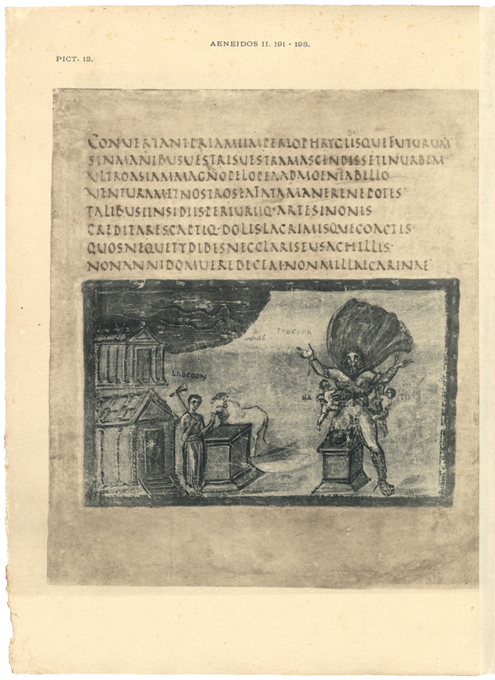
published in Codices e vaticanis
selecti phototypice expressi, vol. 1 (1899),
f. 18v: the miniature shows the episode of
Laocoon
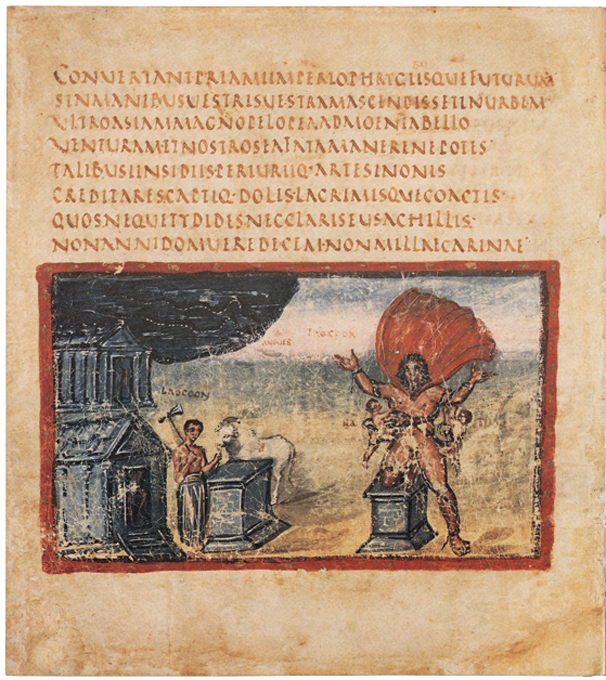
published in Codices e vaticanis selecti
phototypice expressi, vol. 40 (1980), f. 18v
The same shared perspective of conservation and diffusion, but on a broader basis, is at the origin of the series Codices ex ecclesiasticis Italiae bibliothecis delecti phototypice expressi, created in order to provide the numerous and ancient ecclesiastical libraries of Italy with a means of preserving and making available some of their most valuable manuscripts, many of which were restored in the laboratory of the Vatican Library.
Father Ehrle was also behind the interest taken in the old, engraved maps of Rome; it was his idea to make these widely available in phototype reproductions, accompanied by detailed introductions, published in the series more Piante maggiori di Roma riprodotte in fototipia, which began in 1908.
Another branch of the Vatican Library's publishing activities is composed of publications aimed at making available, with appropriate reproductions, the archaeological, artistic and numismatic collections of the Library, and also of the Sacred and Secular Museums (which were administered by the Library until 1999), and of the Pontifical Galleries and Apartments, which house collections of many works of art. These are the series Medagliere della Biblioteca Vaticana and the related Quaderni; the Museo Sacro della Biblioteca Apostolica Vaticana, and also Studi e documenti per la storia del Palazzo apostolico vaticano. Also in this category are the Inventari dell´Archivio Segreto Vaticano which includes a great deal of sigillographic material (including seals of gold and other precious materials) which is owned by the institution.
Also in the field of illustrated publications, 1944 saw the launch of the series Monumenta Cartographica Vaticana. The creation of a specific series was aimed at achieving a work which would systematically illustrate the cartographic collections of the Library. It consists of phototype editions of cartographic material - planispheres, atlases, nautical maps - preserved but as yet unpublished (or only partially published in the manuscripts and printed collections of the Library and in the Vatican Palaces, e.g. the large maps that decorate the east and central wings of the Loggias of Raphael, and those of Italy which adorn the so-called Gallery of Maps.
This presentation of the publishing activities of the Library in three main parts (the Catalogi, Studi e testi and facsimile and illustrated editions) does not give a complete picture, which would also need to include other significant collections.
All series are available in the BOOKSHOP.
CONTACT DETAILS
- Academic Director of BAV Publishing: Dr. Delio Vania Proverbio contact by email
- Telephone: +39/06698.79496
- Deputy-Director of BAV Publishing: Dr. András Német contact by email
- Telephone: +39/06698.79451



